e-Postcard
from Our Greece Sojourn
with Chris and Rick Hamill
5/20 to 6/5/2008
Γεια
σου (hello)!
Those of you who have followed our travels throughout the years have been subjected to periodic e-postcards. Here we go again! On May 20th Tim and Di, along with our great friends Chris & Rick Hamill, began a 16 day trip to see the antiquities of mainland Greece and the isle of Crete.
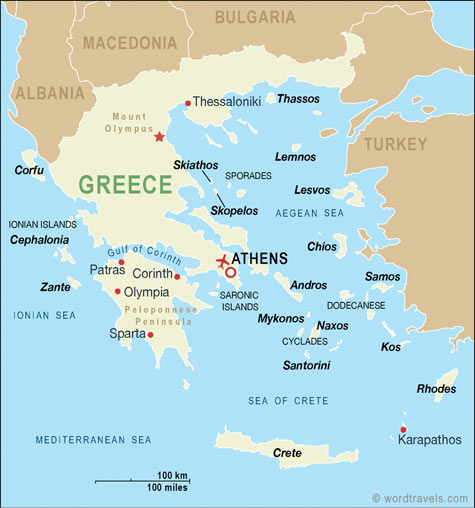 In general, the trip included two days in Athens, a five day guided private tour of northern Greece, two more days in Athens, three days in Crete, and a final four days in Athens. Rather than a day-by-day description of what happened, here are some observations on topics of interest.
In general, the trip included two days in Athens, a five day guided private tour of northern Greece, two more days in Athens, three days in Crete, and a final four days in Athens. Rather than a day-by-day description of what happened, here are some observations on topics of interest.
A very brief introduction to Greece: Earliest human settlements date back from 7000 BC, with evidence of villages (complete with town square) from 3000 BC. Greece was invaded by at least twelve groups by the 1450s, most importantly the Romans and the Turks. It became an independent monarchy in 1829, invaded by Nazis, became a republic, had a self appointed right-wing president, invaded by Turks again in the north, had a military coup, then became a republic again. Add to that periodic major earthquakes, an occasional volcanic eruption, and several civil wars. This country has had its share of cultural upheaval, but seems to adapt, adopt what it can and keep on going.
Athens – This city of 5 million is built on many hills, the tallest of which is topped by the Acropolis (“high city”) which contains the famous Parthenon. No wonder it is a symbol of Athens. The Acropolis can be seen from all around the city. We used it as a reference point while walking in the city see how lost we were. We could even see it from the rooftop breakfast area of our hotel (see below). The Acropolis is lit up at night, making for a stunning sight and the source of many photos by the guys.
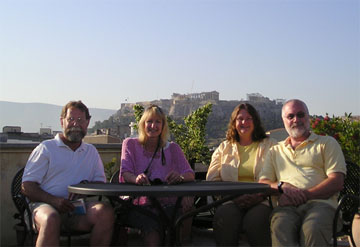 Although the actual Parthenon area is usually packed with tourists, we made an early morning visit to the nearby Agora (ancient Roman marketplace) with its still visible sewage system and found few people around… it was like having the site to yourself.
Although the actual Parthenon area is usually packed with tourists, we made an early morning visit to the nearby Agora (ancient Roman marketplace) with its still visible sewage system and found few people around… it was like having the site to yourself.
As you walk the neighborhoods of this city, you notice a few things. First, the people are very friendly. No matter how rushed they are, they are always courteous and willing to help. Also, there are endless numbers of restaurants and tavernas, most with outdoor seating in the summer and very little franchise fast food. The typical Greek has a small breakfast (coffee and roll), a large lunch about 1, at least one break for coffee/drinks/snacks in the late afternoon, and dinner starting after 9 p.m. (sometimes at midnight). This is followed by hours at the club (for the younger folks). Several Greeks we talked to claimed they only slept 5-6 hours a night, but we have to wonder about the efficiency of the people at work the next day!
There is an unbelievable amount of graffiti everywhere in Athens – on public buildings, shops, construction sites, everywhere you look. Only the numerous churches and ancient ruins seem untouched. There seems to be little effort by anyone to control or remove the graffiti. Along with this was the sad condition of many public areas. Untended parks and gardens along with abandoned former Olympic venues gave the impression that the city lacked the money and/or people to clean things up. Perhaps the Olympics cost the city much more than anticipated.
An entertaining (but potentially dangerous) part of Athens (and much of Greece) was the traffic. White lane markers are generally ignored. Since most of the cars are smaller than in the U.S., the motorcyclists feel free to drive at high speeds between lanes of cars, busses and trucks, often weaving through traffic to squeeze into any perceived space (even sidewalks). Many of the bikers are without helmets. We were amazed to see young women riding in high heels! There are so many cars in Athens that you can only drive into the city center on odd or even days, depending on your license plate.
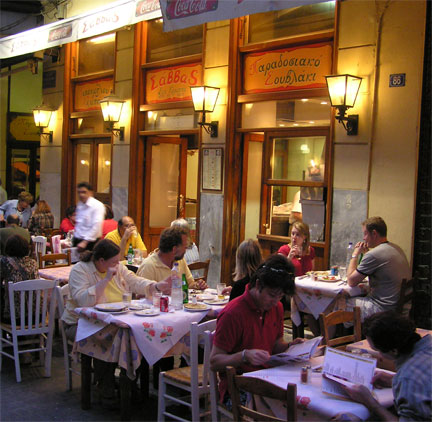 There is very little parking so people park (or double or triple park) on any available space including corners. Luckily, we never had to drive ourselves anywhere -- it was truly taking your life in your hands to even cross the street at times!
There is very little parking so people park (or double or triple park) on any available space including corners. Luckily, we never had to drive ourselves anywhere -- it was truly taking your life in your hands to even cross the street at times!
Don’t get the impression that we didn’t like Athens. It really is a city of interesting neighborhoods. The center of the city is the Plaka, an area teaming with restaurants, souvenir shops, expensive clothing and jewelry shops, more souvenir shops and an occasional gelato (Italian ice cream) store. This is the central hub for tourists and we would return here many times to eat and watch the people.
Outside the city center were hundreds of small specialty shops selling the clothing, plumbing, food, furniture and other items the local people need. Aside from a few larger stores downtown and an IKEA, there were no mega malls – people bought what they needed locally. English was widely spoken and usually there was an English version of menus available. If not, the point and smile method worked just fine in the bakery and vegetable market.
What was really a wonderful surprise about Athens is the abundance of ancient buildings. Besides the major sites like the Acropolis, the Agora (ancient market place) and numerous Temples to Zeus, Apollo and/or Dionysus, there were lots of places where protecting antiquities is a priority. Like many ancient cities, newer buildings were put on top of older ones throughout the centuries. We saw one small site where, while digging for a basement, the workers found huge ancient pottery jars and other artifacts.
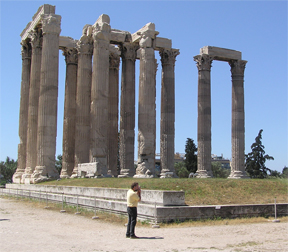 Usually, construction comes to a halt. However, one solution has been to build a glass floor in the new building so that the antiquities can be seen and kept undisturbed. It wasn’t unusual to see a “sunken” 15th or 16th century church surrounded by modern structures built on higher present day “ground level”. We even passed by a tiny chapel on a main road with the Mercedes dealership built around it. Sometimes no more than a few ancient columns, these pockets of the past were a delight.
Usually, construction comes to a halt. However, one solution has been to build a glass floor in the new building so that the antiquities can be seen and kept undisturbed. It wasn’t unusual to see a “sunken” 15th or 16th century church surrounded by modern structures built on higher present day “ground level”. We even passed by a tiny chapel on a main road with the Mercedes dealership built around it. Sometimes no more than a few ancient columns, these pockets of the past were a delight.
Two outstanding museums are also found here, which we visited at the end of the trip. The National Antiquities Museum had an incredible collection of gold (including the solid gold mask of Agamemnon) and hundreds of vases and statues. The Benaki museum was a private collection containing the best art and artifacts pilfered (as Rick would say) from sites all around Greece. It was arranged in chronological order and helped us understand a little more how the numerous invaders and kingdoms of Greece influenced its arts and weaponry.
Traveling around the mainland – After a couple of days in Athens, we began our private tour of the northern sights. It was a luxury to travel in a bus with just us four, our guide Thales and our driver Manos. Thales, a gentleman slightly older than ourselves, was multilingual, knowledgeable about Greek history, religion, and culture, and could do a great imitation of the British upper class. He would fill us in with tales of gods and battles, pointing out the details at the places we visited. Manos, the consummate Greek driver, held his own among the narrow streets and aggressive motorcyclists.
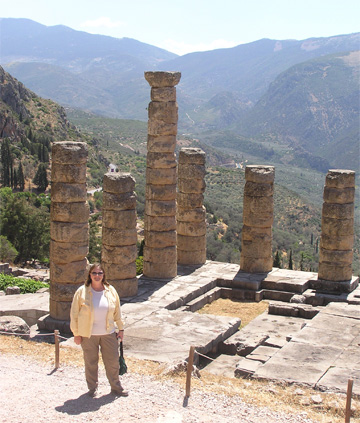 This mode of travel sure beat the herd of tourists we saw getting off of the big busses. We would usually start early in the morning and try to beat the crowds.
This mode of travel sure beat the herd of tourists we saw getting off of the big busses. We would usually start early in the morning and try to beat the crowds.
The ride through the Greek countryside was varied and delightful. Most of the land was dry and without much vegetation, except for colorful oleander flowers along the freeway. Huge mountains nestled with small villages gave way to great fertile valleys planted with grapes, kiwis, olives, apricots, corn and wild poppies. Along the side of the road were occasional small birdhouse sized shrines, containing icons and candles. These, we learned, were markers for fatal traffic accidents. I saw several that had been run over…
One day was spent at Delphi. Located high in the mountains about 175 km northwest of Athens, many important people came here to get personal and political questions answered by the oracle. Originally, we were told, the oracle was a virgin who would, after being drugged, gave unintelligible answers to the question. These answers were then “interpreted” by a priest. Usually the answers were so vague, that they could always be considered true (like today’s horoscope). After a series of elopements by the virgins, a woman over 50 became the oracle (Chris & Di think she would be more dependable anyway). The site included ruins of several temples and treasuries, where valuables offerings were stored. Delphi was considered by ancient Greeks as the navel (center) of the earth.
One of the most surprising sites was Meteora. These gigantic rock pinnacles are topped by monasteries, built into the mountain during the 11th through 15th centuries. Until the 1920s, they were only accessible by being hauled up the side of the rock in a basket. This seriously limited unwanted visitors. Now, you can drive fairly close, then take numerous stairs carved into the rock. The monasteries we visited (still in use) had beautiful chapels covered floor to ceiling by Byzantine frescoes painted in gold and bright colors. There were also abundant rose gardens.
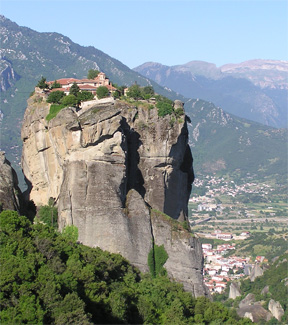 If you saw the James Bond movie For Your Eyes Only, you saw the Holy Trinity Monastery, which we visited.
If you saw the James Bond movie For Your Eyes Only, you saw the Holy Trinity Monastery, which we visited.
Other sites included a 7,000 year old settlement (restoration) of houses on stilts, waterfalls, Mt. Olympus (from a distance), an 18th century restored Turkish home, and Dion, the sacred city of Macedonia. The ruins here cover a large area. There are still stone streets and mosaic floors from 200 AD clearly visible. The outlines of homes, public baths, stone toilets, sewage system (stone troughs), and small temples allowed us to visualize life back then. These were far more extensive than we had pictured. Although many of the original mosaics were in the museum that was closed, it was still an inspiring place. Alexander the Great worshipped here before going off to conquer the world!
We stayed two days in Thessalonica, a large city in Macedonia (an area of northern Greece). Don’t confuse this with the country of Macedonia (as we were told) north of Greece.
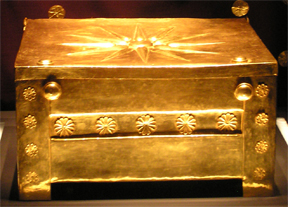 The battle over who own the name Macedonia is still being fought! In the Thessalonica museum we saw many of the treasures found in King Philip (father of Alexander the Great) of Macedonia’s tomb (300 BC). These included golden masks, crowns and jewelry, weaponry, and even (supposedly) Philip’s skeleton. The workmanship of the jewelry and crowns were very fine, fragile and ornate. National Geographic’s recent article on this treasure didn’t do it justice. As we headed back to Athens, we stopped at Thermopylae, where 300 Spartans fought thousands of Persians (and lost). The recent movie The 300 was about this battle.
The battle over who own the name Macedonia is still being fought! In the Thessalonica museum we saw many of the treasures found in King Philip (father of Alexander the Great) of Macedonia’s tomb (300 BC). These included golden masks, crowns and jewelry, weaponry, and even (supposedly) Philip’s skeleton. The workmanship of the jewelry and crowns were very fine, fragile and ornate. National Geographic’s recent article on this treasure didn’t do it justice. As we headed back to Athens, we stopped at Thermopylae, where 300 Spartans fought thousands of Persians (and lost). The recent movie The 300 was about this battle.
The Island of Crete – After a couple more days in Athens, with a side trip to the scenic Sounion Temple of Zeus, we flew to Crete, Greece’s largest island and stayed in Heraklion, its largest city. We were happily on our own here. Crete was far less hectic and crowded than Athens.
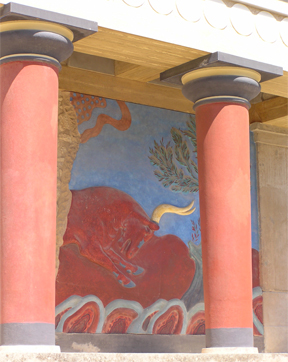 We used the local buses to visit the restored ruins of Knossos (a Minoan palace, originally with beautiful mosaics), an excellent aquarium (with signs in five languages) and the Venetian-influenced towns of Hania and Rethmyno. When the Venetians took over western Crete in 1200 AD, they built huge stone fortresses in these towns, which are still standing. Back in Heraklion we walked the market and had some wonderful seafood dinners. At the museum we saw Minoan art, some of which is quite modern looking and some of the original Knossos mosaics.
We used the local buses to visit the restored ruins of Knossos (a Minoan palace, originally with beautiful mosaics), an excellent aquarium (with signs in five languages) and the Venetian-influenced towns of Hania and Rethmyno. When the Venetians took over western Crete in 1200 AD, they built huge stone fortresses in these towns, which are still standing. Back in Heraklion we walked the market and had some wonderful seafood dinners. At the museum we saw Minoan art, some of which is quite modern looking and some of the original Knossos mosaics.
Sidetrips – During our last stop in Athens, we took a day tour of two sites in the Peloponnesus peninsula, west of Athens. By this time we were pretty spoiled. After having a private tour, it was difficult to sit on a crowded bus of 50+ people, waiting for everyone to get on and off. We visited the hilltop Mycenae palace, the center of the most powerful kingdom in Greece from 1600 – 1200 BC. Homer mentioned the area in the Iliad and the Odyssey as “rich in gold”. Also, we spent a little time at Epidaurus, an almost intact theater built in the third century AD. The acoustics are wonderful. When a person stood in the center of the stage and sang (as several tourists did), you could clearly hear them (unamplified) anywhere in this theater for 14,000 people.
Unfortunately, we didn’t really have much time at either stop. In the true nature of group tours, however, we did have time to make two “rest stops”, a leisurely lunch at a tourist restaurant, and an overly long stop at a massive souvenir shop where you could buy handmade reproductions of old vases, Spartan helmets, and other “rememberances” (as our guide called them) of the tour.
 That’s what we don’t like about this way of touring. You spent too much time picking up and dropping off people at their hotels, stopping for rests and souvenirs, and waiting for the inevitable late people to get on the bus.
That’s what we don’t like about this way of touring. You spent too much time picking up and dropping off people at their hotels, stopping for rests and souvenirs, and waiting for the inevitable late people to get on the bus.
Food – We quickly learned that eating out in Greece has two levels. When you sit down at any restaurant, you are automatically charged a table fee and 13% gratuity. Bread and water usually arrive for an additional fee. The food is more expensive than if you eat the same item as take away. So a souvlaki (pita loaded with rotisserie pork or chicken, cucumber sauce, tomato, onion, and French fries) costs about 2 euros as take away and 8 euros if you sit down and eat it. There is no “no smoking” area in a Greek restaurant. Lots of people smoked and they inevitably sat at the table next to you. In fact, only in the churches and museums did we see no smoking signs.
Besides souvlaki, we ate Greek salad every day. This was cukes, tomatoes, onions, olives, feta, and olive oil/wine vinegar – no lettuce or beets. Breakfast was very thick yogurt with granola (when we were on our own) and eggs, olives, tomatoes, feta and olive oil/vinegar at the buffets.
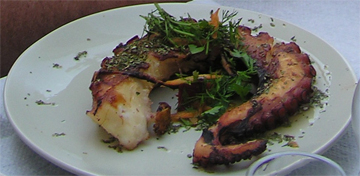 At a couple of restaurants we tried calamari while the Hamills had octopus and cuttlefish. Almost everything is doused in olive oil, which we happily mopped up with hunks of bread.
At a couple of restaurants we tried calamari while the Hamills had octopus and cuttlefish. Almost everything is doused in olive oil, which we happily mopped up with hunks of bread.
Greek coffee is an experience. You order it sweet, medium or plain. It comes in a very small cup and is a very strong, thick dark liquid. About 2/3 of the way down, it starts getting thicker and somewhat crunchy – the grounds are at the bottom of the cup – we learned the hard way that they are not to be consumed.
We rounded out the meals with local cherries and apricots, and a more than occasional gelato. The best was melon, a light green icy version of the sweetest melon you ever had.
Money – The Euro (worth about $1.56) is the currency of Greece. Since it was depressing to think about the exchange rate, we just thought of a Euro as a dollar, since we were going to buy that gelato anyway! There are one Euro and two Euro coins, tiny 1 cent coins and the biggest coin is the 50 cent piece.
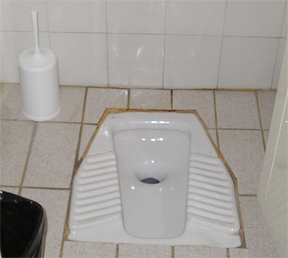 Many places just round up to the nearest 10 cents, but you can easily get stuck with a pocket of heavy change.
Many places just round up to the nearest 10 cents, but you can easily get stuck with a pocket of heavy change.
Personal Hygiene – One thing about the Greeks, they (unlike the British) don’t spend much money on public toilets. It was very unpredictable. The commode was either standard or without a seat or non-existent (just a ceramic hole with a place to put your feet or a wooden shack at a mountaintop monastery). Toilet paper was either abundant, available for a fee from the mean looking attendant at the entrance or non-existent. All possible combinations of the above were found, and the remoteness of the facility was no indication of what you would find within!
Taking a shower was also an adventure. In 16 days we never saw anything but a hand-held shower head. The shower itself could be the entire bathroom with or without a curtain (a soggy mess in either case), a circular curtain so long it blocked the drain, or a claw-footed bathtub (no curtain) that required yoga-like positions to get you clean but not flood the floor. Another indication of how spoiled we are!
Language – It was a good thing that so many people here speak English. In fact, lots of ads, billboards and other signs were either totally in English or sprinkled with words we recognized.
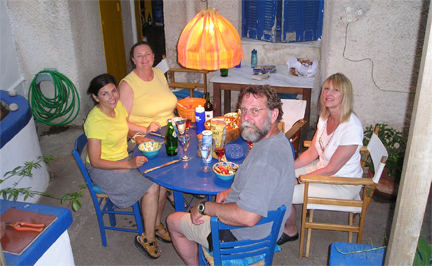 We had a phrasebook with us and (after much mumbling) both Rick and Di could sound out most of the Greek words we saw. The problem is, even if you know how to pronounce “σπρώχν” as “sprok-no”, you still don’t know if that sign on the door means push, pull, do not enter, or for rent! (It means push – which you find out after trying to pull the door open.)
We had a phrasebook with us and (after much mumbling) both Rick and Di could sound out most of the Greek words we saw. The problem is, even if you know how to pronounce “σπρώχν” as “sprok-no”, you still don’t know if that sign on the door means push, pull, do not enter, or for rent! (It means push – which you find out after trying to pull the door open.)
All in all, it was a wonderful trip. Seeing sites that you had heard about for years, or saw in movies and magazines was exciting. Our travel companions were great and we could still laugh after 16 days. We were getting a little overwhelmed with old vases, marble columns and temple of Zeus, so it was time to get home.
Αντίο (goodbye) and Ευχαριστώ (thanks).
Di & Tim
P.S. Looks like we returned just in time. An earthquake (6.5) struck Sunday about 120 km from Athens. A 24-hour strike (protesting low wages) in parts of Greece started today (Monday) morning including bus, train, some plane travel and other services. The continuous upheaval in Greece continues on several fronts.
 In general, the trip included two days in Athens, a five day guided private tour of northern Greece, two more days in Athens, three days in Crete, and a final four days in Athens. Rather than a day-by-day description of what happened, here are some observations on topics of interest.
In general, the trip included two days in Athens, a five day guided private tour of northern Greece, two more days in Athens, three days in Crete, and a final four days in Athens. Rather than a day-by-day description of what happened, here are some observations on topics of interest.
 Although the actual Parthenon area is usually packed with tourists, we made an early morning visit to the nearby Agora (ancient Roman marketplace) with its still visible sewage system and found few people around… it was like having the site to yourself.
Although the actual Parthenon area is usually packed with tourists, we made an early morning visit to the nearby Agora (ancient Roman marketplace) with its still visible sewage system and found few people around… it was like having the site to yourself.
 There is very little parking so people park (or double or triple park) on any available space including corners. Luckily, we never had to drive ourselves anywhere -- it was truly taking your life in your hands to even cross the street at times!
There is very little parking so people park (or double or triple park) on any available space including corners. Luckily, we never had to drive ourselves anywhere -- it was truly taking your life in your hands to even cross the street at times!
 Usually, construction comes to a halt. However, one solution has been to build a glass floor in the new building so that the antiquities can be seen and kept undisturbed. It wasn’t unusual to see a “sunken” 15th or 16th century church surrounded by modern structures built on higher present day “ground level”. We even passed by a tiny chapel on a main road with the Mercedes dealership built around it. Sometimes no more than a few ancient columns, these pockets of the past were a delight.
Usually, construction comes to a halt. However, one solution has been to build a glass floor in the new building so that the antiquities can be seen and kept undisturbed. It wasn’t unusual to see a “sunken” 15th or 16th century church surrounded by modern structures built on higher present day “ground level”. We even passed by a tiny chapel on a main road with the Mercedes dealership built around it. Sometimes no more than a few ancient columns, these pockets of the past were a delight.
 This mode of travel sure beat the herd of tourists we saw getting off of the big busses. We would usually start early in the morning and try to beat the crowds.
This mode of travel sure beat the herd of tourists we saw getting off of the big busses. We would usually start early in the morning and try to beat the crowds.
 If you saw the James Bond movie For Your Eyes Only, you saw the Holy Trinity Monastery, which we visited.
If you saw the James Bond movie For Your Eyes Only, you saw the Holy Trinity Monastery, which we visited.
 The battle over who own the name Macedonia is still being fought! In the Thessalonica museum we saw many of the treasures found in King Philip (father of Alexander the Great) of Macedonia’s tomb (300 BC). These included golden masks, crowns and jewelry, weaponry, and even (supposedly) Philip’s skeleton. The workmanship of the jewelry and crowns were very fine, fragile and ornate. National Geographic’s recent article on this treasure didn’t do it justice. As we headed back to Athens, we stopped at Thermopylae, where 300 Spartans fought thousands of Persians (and lost). The recent movie The 300 was about this battle.
The battle over who own the name Macedonia is still being fought! In the Thessalonica museum we saw many of the treasures found in King Philip (father of Alexander the Great) of Macedonia’s tomb (300 BC). These included golden masks, crowns and jewelry, weaponry, and even (supposedly) Philip’s skeleton. The workmanship of the jewelry and crowns were very fine, fragile and ornate. National Geographic’s recent article on this treasure didn’t do it justice. As we headed back to Athens, we stopped at Thermopylae, where 300 Spartans fought thousands of Persians (and lost). The recent movie The 300 was about this battle.
 We used the local buses to visit the restored ruins of Knossos (a Minoan palace, originally with beautiful mosaics), an excellent aquarium (with signs in five languages) and the Venetian-influenced towns of Hania and Rethmyno. When the Venetians took over western Crete in 1200 AD, they built huge stone fortresses in these towns, which are still standing. Back in Heraklion we walked the market and had some wonderful seafood dinners. At the museum we saw Minoan art, some of which is quite modern looking and some of the original Knossos mosaics.
We used the local buses to visit the restored ruins of Knossos (a Minoan palace, originally with beautiful mosaics), an excellent aquarium (with signs in five languages) and the Venetian-influenced towns of Hania and Rethmyno. When the Venetians took over western Crete in 1200 AD, they built huge stone fortresses in these towns, which are still standing. Back in Heraklion we walked the market and had some wonderful seafood dinners. At the museum we saw Minoan art, some of which is quite modern looking and some of the original Knossos mosaics.
 That’s what we don’t like about this way of touring. You spent too much time picking up and dropping off people at their hotels, stopping for rests and souvenirs, and waiting for the inevitable late people to get on the bus.
That’s what we don’t like about this way of touring. You spent too much time picking up and dropping off people at their hotels, stopping for rests and souvenirs, and waiting for the inevitable late people to get on the bus.
 At a couple of restaurants we tried calamari while the Hamills had octopus and cuttlefish. Almost everything is doused in olive oil, which we happily mopped up with hunks of bread.
At a couple of restaurants we tried calamari while the Hamills had octopus and cuttlefish. Almost everything is doused in olive oil, which we happily mopped up with hunks of bread.
 Many places just round up to the nearest 10 cents, but you can easily get stuck with a pocket of heavy change.
Many places just round up to the nearest 10 cents, but you can easily get stuck with a pocket of heavy change.
 We had a phrasebook with us and (after much mumbling) both Rick and Di could sound out most of the Greek words we saw. The problem is, even if you know how to pronounce “σπρώχν” as “sprok-no”, you still don’t know if that sign on the door means push, pull, do not enter, or for rent! (It means push – which you find out after trying to pull the door open.)
We had a phrasebook with us and (after much mumbling) both Rick and Di could sound out most of the Greek words we saw. The problem is, even if you know how to pronounce “σπρώχν” as “sprok-no”, you still don’t know if that sign on the door means push, pull, do not enter, or for rent! (It means push – which you find out after trying to pull the door open.)